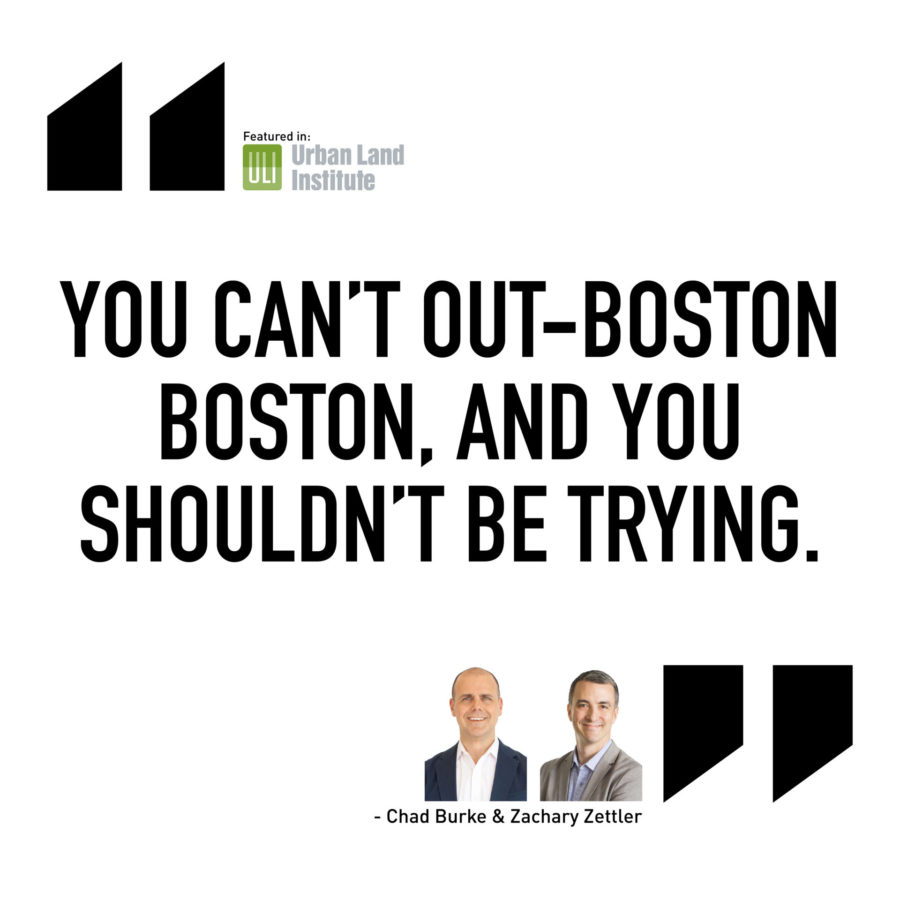Insights
Mar 15, 2022 _ insights
You Can’t Out-Boston Boston: Retooling Innovation Districts for Medium-Sized Cities
Over the last decade, we’ve seen innovation districts multiply across the country. However, the thinking about them hasn’t kept pace with their changing geographical reality. How should the development strategy around innovation districts change as they shift from primarily large, coastal cities (like Boston and Seattle), where they’re anchored by some of the world’s most powerful companies and universities to smaller, less well-resourced cities?
Colleagues Chad Burke and Zachary Zettler recently published part two of an ongoing series of articles exploring the history and changing trajectory of innovation districts in the Urban Land Institute’s publication Urban Land Magazine.
Providing a brief history of innovation districts, we argue that for smaller cities to compete, they need to develop a well-targeted specialization of their innovation district that is based on the principle of “knowing yourself” (knowing your strengths, your emerging industries, your established lines of research, and so on) and flexing those strengths to distinguish your district from others. We stress the importance of establishing the right partnerships and placemaking strategies that make the most of a location’s existing strengths.
You can read the full text at Urban Land Magazine.
Part one of this series, “A New Model for Innovation,” can be found here.
The article features our work at Terrex and University of Cincinnati’s Digital Futures Building (within the Cincinnati Innovation District) and the Roundhouse in Pittsburgh’s burgeoning innovation district at Hazelwood Green.
 Chad Burke, AIA, LEED AP is the Director of Commercial & Workplace at GBBN. Overseeing the firm’s Commercial Mixed-Use and Workplace projects, Chad works closely with developers and workplace clients to design solutions that meet their short and long-term needs. His work includes University of Cincinnati’s Digital Futures, Hillrom’s Innovation Center, Uptown Gateway, and Thompson Hine’s Office Renovation. Learn more about his approach to workplace projects here.
Chad Burke, AIA, LEED AP is the Director of Commercial & Workplace at GBBN. Overseeing the firm’s Commercial Mixed-Use and Workplace projects, Chad works closely with developers and workplace clients to design solutions that meet their short and long-term needs. His work includes University of Cincinnati’s Digital Futures, Hillrom’s Innovation Center, Uptown Gateway, and Thompson Hine’s Office Renovation. Learn more about his approach to workplace projects here.
 Zachary Zettler, AIA, LEED AP is GBBN’s Director of Higher Education. With over 20 years’ experience designing campus spaces, Zachary is a trusted advisor to our university clients and a recognized leader in higher education design. Zachary’s work includes Miami University’s Stanton Hall Renovation, University of Cincinnati’s Marian Spencer Hall, and University of Cincinnati’s Digital Futures. He has also published insights on repurposing campus spaces and predictive analytics in university masterplans.
Zachary Zettler, AIA, LEED AP is GBBN’s Director of Higher Education. With over 20 years’ experience designing campus spaces, Zachary is a trusted advisor to our university clients and a recognized leader in higher education design. Zachary’s work includes Miami University’s Stanton Hall Renovation, University of Cincinnati’s Marian Spencer Hall, and University of Cincinnati’s Digital Futures. He has also published insights on repurposing campus spaces and predictive analytics in university masterplans.




